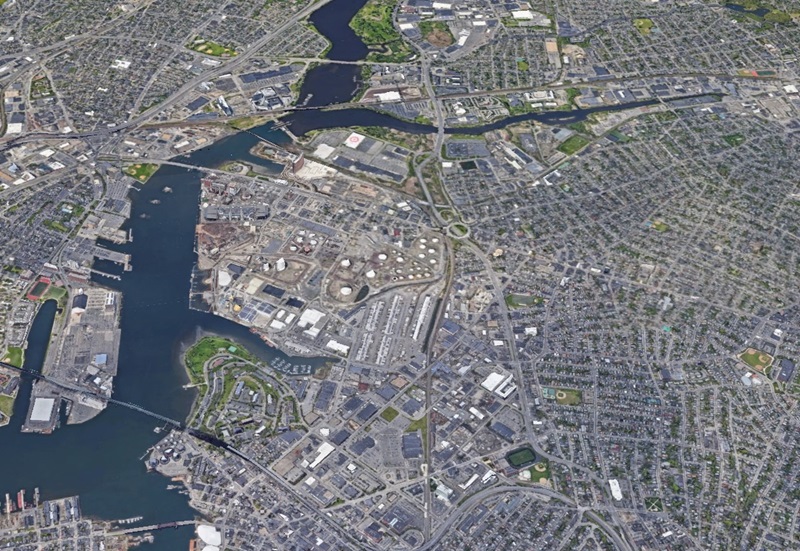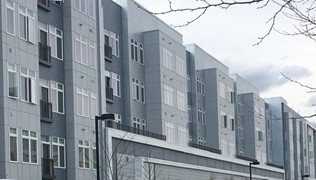Launch Regional Governance for the Six-City Growth District by the Mystic and Malden Rivers
A Proving Ground for City Builders
By Amy Dain, Dain Research
April 8, 2021
Greater Boston’s biggest growth node straddles the Mystic and Malden Rivers, at the intersections of six cities: Somerville, Medford, Malden, Everett, Chelsea, and Boston at Charlestown. Apartments, stores, hotels, offices, labs, and entertainment complexes have been rising like a city center. Companies are selecting it for headquarters. Long polluted lands have been getting cleaned and capped. And rowers are taking to the rivers now safe for boaters. And yet, the growth district is decidedly not like a city center.
At the edges of six municipalities, it is an archipelago of private developments connected first of all by problems of traffic, social inequality, and environmental stress, and only secondarily by train lines, rivers, bike routes, walking paths, public spaces, and civic identity. No government body is now charged with managing its growth into a coherent, connected, and inclusive place.
City growth is a good and necessary thing: It fulfills fundamental human needs for shelter, mobility, and social interaction. But car-oriented, gated-style growth has been dominating much development, even where city-scaled density should favor walkability, public transportation, public spaces, and diversity. Greater Boston has not built a new pulsing, diverse downtown in a hundred years. It can be done. The six-city area is Greater Boston’s preeminent proving ground for city builders.
Developers are already showing up. A proposal for a 21-story residential tower in Everett grabbed recent headlines. Not many Boston metro cities aside from Boston itself allow that kind of height. And not every area has the market to support such height. Diners in the planned tower’s top-floor restaurant, The Sky, will take in views of the Boston skyline and the nearby glimmering Encore Casino. Views from The Sky will also showcase a vast expanse of gritty industrial properties below. In the last decade, the City of Everett has undertaken several re-zonings to usher in growth and environmental cleanup that could, over time, transform the landscape from grit to gloss. In 2015, 328 dwelling units went up, in the Batch Yard, on the site of the old Charleston Chew factory, next to the casino. A rough count of residential units in buildings recently constructed, recently permitted, or now under review comes to 3,000. Everett’s zoning would allow plenty more after that.
Not only Everett has been rising by the rivers. Right over Everett’s border with Chelsea, the count of new and planned buildings covers another thousand dwelling units. Then across the Mystic from Everett, it ticks up by yet another thousand at Somerville’s Assembly Row, where Partners’ headquarters opened in 2016, along with offices, hotels, and retail space. Across the Malden River from Everett, in Medford, the count increases by 2,500. That includes Station Landing, with 460 dwelling units as well as retail and offices, and Rivers Edge, with more than 500 apartments as well as retail and offices. Potentially out-rising all of these developments is a proposed 29-story tower of 695 residences in Charlestown. In sum, the six-city area is transforming into a formidable regional hub for jobs, housing, shopping and recreation.
Government involvement here should match the scale of the opportunities and challenges. A cross-municipal board should be established, perhaps with a seat for each mayor, key state officials, and community representatives, to oversee a shared fund and make decisions about things like infrastructure improvements, reforms to promote diversity and inclusion, and policies to protect the environment.
The board’s mandate would be to address three primary challenges: mobility, equity, and the environment.
Mobility
Pre-pandemic the area north of Boston was already choked with traffic. Trains were failing and buses over-packed. These problems have continued even during the pandemic. Still, the framework is in place for non-car mobility: Orange Line stations at Wellington and Assembly Row; a rail trail that reaches from Everett through Malden up to Lynn; a commuter line that goes through Everett without a station; the Silver Line bus terminal in Chelsea; rivers that run to Boston Harbor; private shuttles by land and water; bus routes throughout including bus rapid transit; and trails and public parks along the rivers. The area is a natural hub with spokes reaching up the coast to Lynn and Salem, up Route 93 to Woburn, up the commuter line to Lawrence and Haverhill, and down into Cambridge and Boston. The area is also a stone’s throw from a number of historic downtowns, such as in Malden, Medford, and Everett. Yet, the existing and emerging mobility infrastructure does not match the scale of current and potential development.
Developments remain largely gated off from one another, and not as well connected to the region as they could be. Take for example the 45 acres at Assembly Row, a paragon of new urbanism, with grid streets, parallel parking, and tall buildings containing first-floor shops that line wide sidewalks. It looks like a traditional bustling downtown except that it is only a few blocks long and has hard edges defined by tracks, river, and highway. It has its own subway station, but residents, revelers, and workers in Everett cannot walk the short distance across the river to the station or to Assembly Row’s restaurants.
Ideas abound for improved connectivity via bus rapid transit, pedestrian bridges over rivers and highways, gondolas, new train stations, shuttles, protected bike routes and more. Leaders of the area’s respective cities should be weighing in together, officially, about which mobility projects are priorities. Assembly Row is such a large-scale project that its developer was able to build a train station to serve it. The Encore Casino could launch its own shuttle systems. Most projects are not that big; it will make sense for the developers to contribute to a shared fund for large scale improvements.
A cross-municipal board should also have the mandate to address parking in a systematic way, to minimize its inclusion within new buildings and decouple parking from apartments and jobs. Ample free in-house parking encourages driving. Making parking slightly less convenient would encourage walking, biking, and the use of public transportation – the bustle of healthy city life.
Equity
Great cities are for everybody and every purpose. The Boston Globe recently lamented that “The city [of Boston] had a rare opportunity to build a new neighborhood for all Bostonians. Instead it built the Seaport.” Decades ago, famed urbanist Jane Jacobs wrote that to generate exuberant diversity, a district must mingle buildings that vary in age and condition. Dated buildings get priced right for small non-profits, startups, artists, students, and low-income residents. Seaport rose from epic parking lots; old buildings were not available for mingling. Brownfields redevelopment on the post-industrial lands along the Mystic and Malden Rivers face a similar issue: Almost everything will be new. Low rents do not cover the cost of construction. The market will not, on its own, deliver new buildings priced for low-income residents and scrappy entrepreneurs. It is the role of government to make sure that diversity gets built in when all-new city-centers rise.
Prior to recent redevelopment, polluted properties walled off densely populated working class neighborhoods from the Mystic and Malden Rivers. There is concern that the walls of waste are getting traded for walls of wealth that will still keep the neighbors out. Upgrades to infrastructure, cleanup of brownfields, construction of expensive housing, offices, and shops, and establishment of riverside parks, combined with a region-wide housing shortage, could put upward pressure on nearby rents. (Or not, in a shaken economy.) When rents go up, some long-time residents adjust by devoting more income to rent and less to other needs; some crowd into apartments to divide the rent among more income-earners; and some move out of the neighborhood. Evictions increase. Local social networks get broken. And the stress of housing instability gets compounded into one heartbreaking story after another. Even without rising rents, the short end of the region’s wide income disparities has long made housing instability a problem here. These are profoundly difficult challenges to manage. A board overseeing the region’s development should have a mandate to address them.
Zoning regulations can require builders to include affordable units on site, and public funds can be directed towards such inclusion. Development fees going to a centralized fund managed by the board could be used for preservation of affordability in the nearby neighborhoods or for grants to nearby neighbors to help with rent or home-buying or home repairs. Funds could also be used to help integrate the district with programming, arts and culture, job incubators, and mentorship programs. Funds could also be directed to support community organizing and local community groups that function to keep existing communities rooted and give voice to the neighbors in how the district gets developed. The area can be planned with new public places for gathering, pop-up stores, food trucks, community art galleries, and various entrepreneurial undertakings. First-floor “retail” spaces can be used for programs for families with small kids. The board could collaborate with foundations and other government departments in creating a robust program for exuberant diversity and inclusion in the district.
Environment
Leaders of Everett, Medford, and Malden already have spent decades collaborating to remediate the lands along the Malden River. They removed more than 1,500 tons of discarded steel, tires, rubber, and other trash. They introduced thousands of wetlands plants where wetlands had long ago been destroyed. Ongoing collaboration on environmental remediation and restoration will be for the public benefit.
Collaboration is also needed to achieve reductions in greenhouse gas emissions associated with settlement of the region, in buildings and transportation systems, and to prepare for changing climate conditions and increased flooding.
***
Greater Boston, of all places, remains remarkably well positioned for prosperity, with strengths in biotech, tech, healthcare, universities, finance, and other sectors. Yet, Greater Boston is not in a period of economic equilibrium. In this unstable moment, some parts of economy and areas of the region appear relatively prosperous, while despair has gripped others. There is giddy banter about a new Roaring 20s, and sober talk about an interconnected world economy that will be on the mend for years. Policymakers need to plan for different scenarios. The formation of a regional board to oversee issues of mobility, equity, and the environment will be beneficial whether the real estate market stays strong or slows dramatically.
City building is not done by private developers alone. The city-scaled developments of the six-city area need dedicated governance to become a great, inclusive, connected, and sustainable metropolitan hub.
Read more proposals in the Seizing the Moment series.


